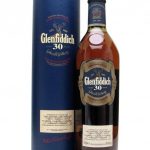Glenfiddich
It was the summer of 1886 when William Grant, a founder of Glenfiddich, had the idea of creating the "best shot of the valley" ("best dram in the valley"). In less than a year William, working hard together with his seven sons and two daughters, built the distillery. Their efforts were not in vain and, on Christmas Day of 1887, the first drop of spirit flowed from small copper stills. William called his distillery Glenfiddich, Gaelic "Deer Valley". 120 years passed and Glenfiddich is now one of the few distilleries of single malt Whisky still wholly family owned and the produced Whisky is one of the most award winning single malt in the world. Only the best malts, those made in respect of the characteristics required by the Glenfiddich Distillery, are selected between those offered by specialized maltsters: the used barley type is Ripe. It is immersed in water for two days and this activates the germination. The barley is left to germinate for four or five days, this process allows the conversion of starch into natural sugar. The resulting "green malt" is dried over a fire and delivered to the distillery as malted barley. The malted barley and crystal clear and fresh water are the main ingredients in the production of Glenfiddich Scotch Whisky single malt. The malted barley is ground into "grist", modified starch, and mixed with pure spring water of Robbie Dhu, from the nearby Conval Hills, heated and then poured into a giant "mash tuns". Here the blades rotate slowly to press, to lift and to sift the mixture and to ensure good sugar drainage. In the mash tuns, the foaming process produces a natural cloud of steam, filling the air with a pleasantly spicy aroma. The warm water reactivates enzymes, inhibited during the drying, that complete the conversion of starch into maltose: it dissolves in water producing about six hours later a sweet liquid called "wort". The wort is drained, cooled and prepared for fermentation. The "Draff", the waste substance of the process, is sold to farmers as feed for their cattle. At this point the yeast is added to the wort. Everything is pumped by the condenser in the traditional wooden containers of fermentation, the "washbacks". The vats are hand made of Douglas fir, rather than the stainless steel used in many other distilleries. This traditional method of production is kept so as not to affect the taste of Whisky. These vats are towering with 17 feet high (5.5 meters) and are filled within 3 feet (1m) from the top. As begins the fermentation the temperature rises from about 19°C to about 33°C, the resulting carbon dioxide creates a massive, hot wort foam that fills the remaining 3 feet (1m) and must be held down with mechanical beaters. After about 64 hours of fermentation, when the furious boiling stops, remains a brown liquid of 8-9% Vol, like a strong beer: the "wash." The heart of the distillation process is in the still of the house, where the wash is distilled in copper stills, which exactly correspond to the shape and the size of the original stills purchased more than a century ago by William Grant. Every bump or dent is still the same so as to avoid the risk of not reproducing the unique taste of Glenfiddich drank by its founder. The stills continue to be heated with "direct fire" (application of a flame directly below the base). The wash in the stills is heated gradually until the alcohol transforms into steam. The steam rises through the gooseneck and is guided down through a water-cooled condenser. This condenses the steam in intermediate liquid, known as "low Wine". The low wines, which contain about 21% alcohol, are heated in very small stills, smaller versions of the wash still, called "spirits still". The vaporized alcohol that is extracted and condensed, flows down to the imposing "spirits safe", made of gleaming brass and glass, where the flow of the spirit can be controlled. The Stillman manages the delicate task of monitoring this distillation because any mistake can ruin the taste of Whisky. Only the central part, the "heart" of distillation is kept for aging. The Stillman extractes it with a simple press of a tap: a new batch of Glenfiddich is born. The new spirit is reduced to 63.5% alcohol with natural spring water in the Robbie Dhu then to be put into hand-made oak barrels. All the barrels filled in Glenfiddich Distillery are first checked by a qualified cooper, a unique practice for the production of Glenfiddich Whisky. The cooper, that must train for about five years, works with incredible speed and agility in assembling, repairing or reconstruct the barrels: is able to make about 25 of them every day. Only the best barrels, made of the best wood, such as of sherry from Spain and of bourbon from America that had only Sherry or Bourbon Whiskey, are used. Softened from the previous use, the oak helps the maturation of Scotch Whisky, allowing it to breathe, soften, acquire subtle flavors and absorb a golden yellow color. Sometimes the inside of the barrel is toasted with a jet of fire to open the wood vains, allowing the Scotch Whisky more easily to interact with it. Since the quality of the barrels is of vital importance, because this is where the magic happens, when it is made a test of the sherry casks pressure, it is used sherry instead of water, so that their integrity is not compromised. It is the only single malt Whisky distillery that still uses wooden barrels (2000 liters per tank). The wooden casks are then stored in traditional warehouses, and the spirit is left to mature. The dark atmosphere, the temperature, humidity and climate of this area offer the ideal conditions for the maturation of the best quality Scotch Whiskys. It is here that the spirit Glenfiddich acquires its distinctive and well-balanced character. With aging in barrels the Whisky breathes the pure air of the Highlands through the porous oak. Consequently evaporate through the wood about 2% of the alcohol compounds from each barrel per year. It is estimated that across Scotland around 16 million liters of Scotch Whisky are lost in this way every year. This lost spirit is known as "the angels' share". Since there are not two distillations of exactly the same taste, before bottling it's done another operation that is no longer used by many distilleries today: "marrying" (assembly). To maintain constant quality of taste, aroma and flavor, there are combined or "got married" several barrels, post-maturation, in a marrying tun, a large oak cask containing about 30 barrels of Whisky. Glenfiddich is the only single malt, which is still made using these marrying tun oak. The Whisky is kept there for up to nine months, so that the different elements are unified in particular and distinctive taste of Glenfiddich Single Malt Whisky. It is an art that is dying in the Whisky's world, but for the creator of Glenfiddich the time spent in marrying tun is important because it ensures that all the flavors of whisky are in harmony and make the product even more unique. When the spirit is matured to perfection, the casks are emptied and the Whisky is "cut" with pure Robbie Dhu spring water. This reduces the volume of alcohol once again bringing it to 40%. Almost the entire range of Glenfiddich single malt Scotch Whisky is bottled in the Glenfiddich Distillery. Glenfiddich is the only Highland single malt distilled, matured and bottled in its own distillery, using a single source of spring water throughout the process.





